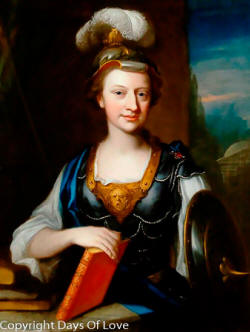

Partner Catherine Talbot
Queer Places:
20 Clarges St, Mayfair, London W1J, Regno Unito
Grosvenor Chapel, 24 S Audley St, Mayfair, London W1K 2PA, Regno Unito
 Elizabeth Carter (16 December 1717 – 19 February 1806) was an English
poet, classicist, writer and translator. She was a member of the
Bluestocking Circle that surrounded
Elizabeth Montagu.[1]
She had a romantic friendship with Catherine Talbot.
The letters exchanged by writers Elizabeth Carter and Catherine Talbot during
their lifelong romantic friendship contained numerous expressions of romantic
and physical love. Elizabeth Carter wrote of her wild emotion for Talbot,
claiming she is absolutely my passion; I think of her all day, dream of her all
night, and one way or other introduce her into every subject I talk of. Talbot
returned her feelings, sending her a lock of her hair and playfully worrying on
one occasion that Carter had fallen in love with another woman, and the first is
forgot.
Elizabeth Carter (16 December 1717 – 19 February 1806) was an English
poet, classicist, writer and translator. She was a member of the
Bluestocking Circle that surrounded
Elizabeth Montagu.[1]
She had a romantic friendship with Catherine Talbot.
The letters exchanged by writers Elizabeth Carter and Catherine Talbot during
their lifelong romantic friendship contained numerous expressions of romantic
and physical love. Elizabeth Carter wrote of her wild emotion for Talbot,
claiming she is absolutely my passion; I think of her all day, dream of her all
night, and one way or other introduce her into every subject I talk of. Talbot
returned her feelings, sending her a lock of her hair and playfully worrying on
one occasion that Carter had fallen in love with another woman, and the first is
forgot.
Born in Deal, Kent, Elizabeth Carter
was the oldest child of Rev. Nicolas Carter, perpetual curate of Deal, and
his first wife Margaret (died c. 1728), only daughter and heir of Richard Swayne
of Bere Regis, Dorset, who died when Elizabeth was ten.[2] Her redbrick family home can still be seen at the junction of
South Street and Middle Street, close to the seafront. Encouraged by her father
to study, she mastered several modern and ancient languages (including Latin,
Greek, Hebrew, and Arabic) and science.
Carter rendered into English Jean-Pierre de Crousaz's ''Examen de
l'essai de Monsieur Pope sur l'homme'' (''Examination of Mr
Pope's "An Essay on Man"'', two volumes, 1739);
Francesco
Algarotti's ''Newtonianismo per le dame'' (''Newtonianism for
women''); and wrote a small volume of poems. However, Carter's position in the
pantheon of 18th-century women writers was ensured by her translation in 1758 of
''All the Works of Epictetus, Which are Now Extant'', the first English
translation of the known works by the Greek stoic philosopher. This work made
her name and fortune, securing her the spectacular sum of £1000 in subscription
money.[3]

Portraits in the Characters of the Muses in the Temple of Apollo
by Richard Samuel
oil on canvas, 1778
52 in. x 61 in. (1321 mm x 1549 mm)
Purchased, 1972
Primary Collection
NPG 4905. Included: Anna Letitia Barbauld (née Aikin) (1743-1825), Poet and writer.
Elizabeth Carter (1717-1806), Scholar and writer. Elizabeth Griffith (1727-1793), Playwright and novelist. Angelica Kauffmann (1741-1807), Painter. Charlotte Lennox (née Ramsay) (1720-1804), Writer. Catharine Macaulay (née Sawbridge) (1731-1791), Historian and political polemicist. Elizabeth Montagu (née Robinson) (1718-1800), Writer and leader of society. Hannah More (1745-1833), Religious writer. Elizabeth Ann Sheridan (née Linley) (1754-1792), Singer and writer.
Grosvenor Chapel
Carter was a friend of Samuel Johnson, editing some editions of his periodical ''The Rambler''.[4] He wrote, "My old friend, Mrs. Carter could make a pudding as well as translate Epictetus from the Greek and work a handkerchief as well as compose a poem."[5]
After Catherine died in 1770, Elizabeth made the acquaintance of the Bluestockings, female intellectuals such as Elizabeth Montagu, and she also knew other great thinkers of the day such as Fanny Burney. Catherine’s mother left a bequest to Elizabeth that enabled her to continue to live independently till her death in 1806, a gesture that suggests she valued the feelings Elizabeth had for her daughter and did not think ill of them.
Carter was friends with many other eminent people, as well
as being a close confidant of Elizabeth Montagu, Hannah More, Hester
Chapone, and other members of the Bluestocking circle. Anne Hunter, a
minor poet and socialite, and Mary Delany were also noted as close
friends.[6] The novelist Samuel Richardson included Carter's poem
"Ode to Wisdom" in the text of his novel ''Clarissa'' (1747–48) without
ascribing it to her. It was later published in a corrected form the
''Gentleman's Magazine'' and Carter received an apology from Richardson.
Carter appeared in the engraved (1777) and painted (1778)
versions of Richard Samuel's ''The Nine Living Muses of Great Britain'' (1779)
but the figures in the painting were so idealised that she complained she could
not identify herself or anyone else in the work. Samuel had not done any
sittings from life when preparing the work.[7]
Fanny Burney is
quoted in Boswell's ''Life of Samuel Johnson'' as saying in 1780 she thought
Carter "a really noble-looking woman; I never saw age so graceful in the female
sex yet; her whole face seems to beam with goodness, piety, and philanthropy."
However, Betsey Sheridan, sister of Richard Brinsley Sheridan, the
playwright, described her five years later in her diary as "rather fat and not
very striking in appearance".
My published books: